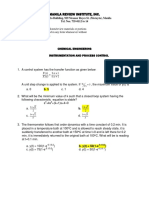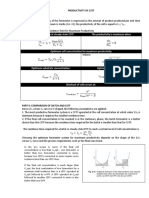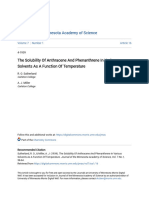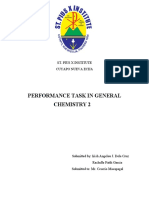Professional Documents
Culture Documents
Module 4
Module 4
Uploaded by
Abi VA0 ratings0% found this document useful (0 votes)
73 views50 pagesThis document summarizes key points from a physical chemistry lecture for engineers on electrolytes and electrochemistry. It discusses the properties of strong and weak electrolytes, how they conduct electricity and dissociate in solution. Various classifications of electrolytes are presented along with how they affect colligative properties like boiling point, freezing point, and vapor pressure. Formulas for calculating these properties are provided. The document also covers electrolysis, the Faraday's laws, and the Nernst equation for determining cell potential under non-standard conditions. Examples of calculations involving these concepts are presented.
Original Description:
Copyright
© © All Rights Reserved
Available Formats
PDF, TXT or read online from Scribd
Share this document
Did you find this document useful?
Is this content inappropriate?
Report this DocumentThis document summarizes key points from a physical chemistry lecture for engineers on electrolytes and electrochemistry. It discusses the properties of strong and weak electrolytes, how they conduct electricity and dissociate in solution. Various classifications of electrolytes are presented along with how they affect colligative properties like boiling point, freezing point, and vapor pressure. Formulas for calculating these properties are provided. The document also covers electrolysis, the Faraday's laws, and the Nernst equation for determining cell potential under non-standard conditions. Examples of calculations involving these concepts are presented.
Copyright:
© All Rights Reserved
Available Formats
Download as PDF, TXT or read online from Scribd
Download as pdf or txt
0 ratings0% found this document useful (0 votes)
73 views50 pagesModule 4
Module 4
Uploaded by
Abi VAThis document summarizes key points from a physical chemistry lecture for engineers on electrolytes and electrochemistry. It discusses the properties of strong and weak electrolytes, how they conduct electricity and dissociate in solution. Various classifications of electrolytes are presented along with how they affect colligative properties like boiling point, freezing point, and vapor pressure. Formulas for calculating these properties are provided. The document also covers electrolysis, the Faraday's laws, and the Nernst equation for determining cell potential under non-standard conditions. Examples of calculations involving these concepts are presented.
Copyright:
© All Rights Reserved
Available Formats
Download as PDF, TXT or read online from Scribd
Download as pdf or txt
You are on page 1of 50
Physical Chemistry for Engineers 2 Lecture
Rey Martin G. Estoque
Adamson University
Chemical Engineering Department
An electrolyte is a substance that dissociates into
charged particles (ions) upon dissolution in a
compatible solvent.
The movement of these ions give electrolytes the
ability to conduct electricity.
Can be classified as strong or weak electrolytes.
Strong Electrolytes Weak Electrolytes
Degree of dissociation Degree of dissociation
is high is low
Electrical conductance Electrical conductance
is good is poor
Common examples are Common examples are
ionic salts strong acids and bases
Some electrolytes are considered to be
intermediate, whose characteristics are between
those of strong and weak electrolytes.
Examples are weak acids and bases.
Electrolytescan be classified according to the
charges of the cation and ion.
Electrolyte Cation Charge Anion Charge Example
1-1 +1 -1 NaCl, KBr
1-2 +1 -2 Na2CO3, K2SO4
2-1 +2 -1 CaCl2, Ba(NO3)2
2-2 +2 -2 MgCO3, CuSO4
1-3 +1 -3 K3PO4
3-1 +3 -1 Fe(NO3)3
2-3 +2 -3 Ca3(PO4)2
3-2 +3 -2 Fe2(SO4)3
Strong electrolytes are ionic substances, and
dissolve completely in water.
The electrical environment of a strongly electrolytic
solution is measured by the Debye-Huckel Theory,
which provides a formula for the ionic strength:
1
𝐼 = 𝐶𝑖 𝑍𝑖2
2
What is the ionic strength in M of a
solution that is 0.2M in ferric sulfate?
What is the ionic strength in M of a
solution that is 0.1M potassium nitrate and
0.2M potassium sulfate?
The presence of electrolytic solutes, whether strong
or weak, affects some of the properties of the pure
solvent. These are called colligative properties, and
are as follows:
1. Boiling point elevation
2. Freezing point depression
3. Vapor pressure lowering
4. Osmotic pressure
The boiling point of an electrolytic solution is higher
than that of the pure solvent.
∆𝑇𝑏 = 𝑖𝑘𝑏 𝑚
kb is the ebullioscopic constant. For water, the
ebullioscopic constant is 0.513 K/m.
The freezing point of an electrolytic solution is
lower than that of the pure solvent.
∆𝑇𝑓 = 𝑖𝑘𝑓 𝑚
kf is the cryoscopic constant. For water, the
ebullioscopic constant is 1.86 K/m.
Thevapor pressure of a liquid solvent in solution is
lower than that of the pure liquid.
∗ ∗
𝑃𝑠𝑜𝑙𝑢𝑡𝑖𝑜𝑛 = 𝑥𝑠𝑜𝑙𝑣𝑒𝑛𝑡 𝑃𝑠𝑜𝑙𝑣𝑒𝑛𝑡
Osmotic pressure is the pressure that must be
exerted on a solution to prevent fluid flow when a
semipermeable membrane separates the solution
from a pure solvent.
𝜋 = 𝑖𝑀𝑅𝑇
If the solvent is not water and the ebullioscopic
and/or cryoscopic constants are unknown, the
following formula can be used:
𝑅𝑇 2 𝑀𝑊
𝐾=
∆𝐻
ΔH is the latent heat of transition (fusion for the
cryoscopic constant, vaporization for the
ebullioscopic constant).
Note: for the ebullioscopic constant, if ΔHvap is not
given, the T.H.E. rule can be applied.
It is used to measure the effect of a solute on the
colligative properties of a solution.
It is the ratio between the actual concentration of
particles produced when the substance is dissolved,
and the concentration of a substance as calculated
from its mass.
It
can be used to measure the degree of dissociation
of a weak electrolyte. From Arrhenius Theory:
𝑖−1
𝛾=
𝑣−1
From Debye-Huckel Theory:
𝑖 = 𝑣 1 − 0.375 𝑧+ 𝑧− 𝐼
The boiling point of water at 749.2 mm Hg
is 99.60˚C. What mass percent of sucrose
(342) should be present in an aqueous
sucrose solution to raise the boiling point
to 100˚C at this pressure?
An aqueous solution at 26.85˚C of 0.72% by
weight HCl freezes at -0.706˚C.
a. Calculate the Van’t Hoff factor i.
b. Calculate the osmotic pressure of the
solution in mmHg.
c. Calculate the boiling point of the
solution in ˚C.
A 0.1m solution of a weak electrolyte
ionizing into two ions freezes at -0.208˚C.
Calculate the degree of dissociation.
An aqueous solution of urea freezes at –
4.65˚C. Calculate the freezing point of a
solution prepared by diluting 150 grams of
this solution with 50 grams of water.
The vapor pressure of water at 25˚C is
23.756 torr. A solution consisting of 18.913
grams of a non-volatile substance in 36
grams of water has a vapor pressure of
20.234 torr. What is the molecular weight
of the solute?
150g of NaCl is dissolved in 300g of diethyl
ether. The boiling point elevation of the
solution is 26K. Normal boiling point of diethyl
ether is 34.6˚C.
a. Assuming that the Trouton-Hildebrand-
Everett Rule applies, compute for the
ebullioscopic constant KB.
b. Compute for the Van’t Hoff factor.
c. Compute for the degree of dissociation (%).
Using the Debye-Huckel Theory, calculate
the Van’t Hoff factor for a 0.04M solution
of potassium phosphate.
States that during electrolysis, the amount of
chemical reaction which occurs at any electrode
under the influence of electrical energy is
proportional to the quantity of electricity passed
through the electrolyte.
𝑄 = 𝐼𝑡 = 𝑛𝐹
A constant current was passed through a
solution of CuSO4 for 1hr and 0.04g of
copper was deposited. What is the
current?
A technician is plating a faucet with 0.86 g
of chromium from an electrolytic bath
containing aqueous Cr2(SO4)3. If 12.5 min is
allowed for the plating, what current is
needed? The atomic mass of Cr is
52.00amu.
What mass of magnesium (24.31) is
produced when 100,000 A is passed
through a MgCl2 melt for 1 hour if the yield
of magnesium is 85%?
Three electrolyte cells A, B, and C
containing solution of ZnSO4, AgNO3, and
CuSO4, respectively are connected in
series. A steady current of 1.5A was passed
through them until 1.45g of silver
deposited at the cathode of cell B. How
long did the current flow? What mass of
copper was deposited?
What quantity of electricity would be
required to reduce 10 g of nitrobenzene,
C6H5NO2, completely to aniline, C6H5NH2
(reaction below)? If the potential drop
across the cell is 2 volts, how much
energy, in calories, is consumed in the
process?
+ −
𝐶6 𝐻5 𝑁𝑂2 + 6𝐻 + 6𝑒 → 𝐶6 𝐻5 𝑁𝐻2 + 𝐻2 𝑂
The Nernst Equation enables the determination of
cell potential under non-standard conditions. It
relates the measured cell potential to the reaction
quotient and allows the accurate determination of
equilibrium constants.
𝑅𝑇 °
𝐸=𝐸=𝐸 − 𝑙𝑛𝐾
𝑛𝐹
For the overall reaction at standard
conditions: Sn(s)+Pb2+(aq)→Sn2+(aq)+Pb(s),
a. What is the value of E˚cell?
b. What is the standard Gibbs energy
change of the reaction?
c. What is the equilibrium constant, K?
Assume that you have a cell that has an
iron (III) concentration of 0.015M and an H+
concentration of 1x10-3M. The cell
temperature is 38˚C. What would the cell
potential be under these conditions?
Suppose that we wish to study the possible
galvanic corrosion between zinc and
chromium. What is the chemical reaction
that takes place and what is the standard
free energy change for that reaction?
Calculate the EMF at 25˚C of the cell
Pt|Sn2+(0.1m),Sn4+(0.01m)||Fe3+(0.5m)|Fe
given that: Fe3++3e-→Fe, E˚=-0.041V;
Sn4++2e-→Sn2+, E˚=0.151V.
Physical Chemistry for Engineers 2 Lecture
Rey Martin G. Estoque
Adamson University
Chemical Engineering Department
You might also like
- Separation ProcessDocument42 pagesSeparation Processsqp67n5h69No ratings yet
- Sample Problem 2Document2 pagesSample Problem 2Sata AjjamNo ratings yet
- Problem 1.1ADocument23 pagesProblem 1.1AJohnathan Ortega MenesesNo ratings yet
- GX Operating Manual v0.4 EDocument38 pagesGX Operating Manual v0.4 EBadmaarag JlssNo ratings yet
- Concepts (Coaching)Document20 pagesConcepts (Coaching)lily cruzNo ratings yet
- Tutorial 3 - CrystallizationDocument3 pagesTutorial 3 - CrystallizationAhmad Muzammil25% (4)
- Compilation of ProblemsDocument14 pagesCompilation of ProblemsYnnoNo ratings yet
- Sample Problem ThermoDocument25 pagesSample Problem ThermoJonnah Faye Mojares0% (1)
- Final Exam CheCalc 02Document2 pagesFinal Exam CheCalc 02Christine FernandezNo ratings yet
- ChE 190 - LE1 - Answer KeyDocument13 pagesChE 190 - LE1 - Answer KeyRose Dane Escobedo DiestaNo ratings yet
- Che 520L: Prelim Exam: Calculations 1Document4 pagesChe 520L: Prelim Exam: Calculations 1Nicole Anne BorromeoNo ratings yet
- Art6 WesterterpDocument8 pagesArt6 WesterterpCristhian GómezNo ratings yet
- CHE 312 Problem Set #2Document4 pagesCHE 312 Problem Set #2rkz93No ratings yet
- Problem SetDocument4 pagesProblem SetR SuyaoNo ratings yet
- ChE Calculations 2Document7 pagesChE Calculations 2niezajanepatna100% (2)
- Process Control ProblemsDocument4 pagesProcess Control ProblemsMarco SarmientoNo ratings yet
- CH Process-CalculationsDocument11 pagesCH Process-CalculationsHrutik NimbalkarNo ratings yet
- Solid Fuels W:oDocument3 pagesSolid Fuels W:oShane PatulotNo ratings yet
- 3.ionic Equilibria and Biochemical ReactionsDocument4 pages3.ionic Equilibria and Biochemical ReactionsbackseeNo ratings yet
- Phychem 1 Review 1 Sept 2015Document2 pagesPhychem 1 Review 1 Sept 2015Jupert Jasser AbellanaNo ratings yet
- 3LE Chem 22Document5 pages3LE Chem 22Adrian NavarraNo ratings yet
- Exam Weekly Exam5Document4 pagesExam Weekly Exam5Gab LibetarioNo ratings yet
- 05-Chem Eng Tools 2016Document11 pages05-Chem Eng Tools 2016Hazel Raditya MizumareruNo ratings yet
- Thermodynamics ProblemsDocument2 pagesThermodynamics ProblemsAlexander Salado IbrahimNo ratings yet
- Flue Gas Analysis and Orsat AnalysisDocument3 pagesFlue Gas Analysis and Orsat AnalysisMddL KnGNo ratings yet
- AT12 MabaoDocument17 pagesAT12 MabaoMichael Alex MabaoNo ratings yet
- Experiment 1Document9 pagesExperiment 1Rizza Mae RaferNo ratings yet
- rr320802 Chemical Reaction Engineering IDocument8 pagesrr320802 Chemical Reaction Engineering ISRINIVASA RAO GANTANo ratings yet
- Heat TransferDocument3 pagesHeat TransferAlbert Junior EvangelistaNo ratings yet
- ACFrOgA3Jfd8opBrwGcc8dXNGVRTX7o9eO3J0cU7F7rQa5CoEWTlyrcxSHxDSq5kYkX5w1IkpyWIhSy68d9Kz J6OGnrBiBQez7ycPdUzK0wUS2DjHXc4uSzpO1H zreWLcK7hE0uG - a25pXTAkH PDFDocument2 pagesACFrOgA3Jfd8opBrwGcc8dXNGVRTX7o9eO3J0cU7F7rQa5CoEWTlyrcxSHxDSq5kYkX5w1IkpyWIhSy68d9Kz J6OGnrBiBQez7ycPdUzK0wUS2DjHXc4uSzpO1H zreWLcK7hE0uG - a25pXTAkH PDFSarah SanchezNo ratings yet
- Gate 1994 PDFDocument16 pagesGate 1994 PDFVammsy Manikanta SaiNo ratings yet
- Solid FuelsDocument20 pagesSolid FuelsFlorenceNo ratings yet
- D D D D DDocument5 pagesD D D D Drazzee yuchengkoNo ratings yet
- 14-Plant Design-Ans Key-Master FileDocument22 pages14-Plant Design-Ans Key-Master FilePaul Philip LabitoriaNo ratings yet
- Ferementer DesignDocument38 pagesFerementer DesignMilton Dela Rosa JrNo ratings yet
- Soln Sa Adsorption PDFDocument2 pagesSoln Sa Adsorption PDFRee ValeraNo ratings yet
- KineticsDocument1 pageKineticsWinsletJoyDauagNo ratings yet
- 2 Cell Kinetics and Fermenter Design Part 2 DiscussionDocument4 pages2 Cell Kinetics and Fermenter Design Part 2 DiscussionEzekielNo ratings yet
- Chap 1 Workshop HandoutDocument2 pagesChap 1 Workshop HandoutHenry RodriguezNo ratings yet
- AsdfghjklDocument4 pagesAsdfghjklJV CustodioNo ratings yet
- Humidification and Drying ProblemsDocument2 pagesHumidification and Drying ProblemsKuo SarongNo ratings yet
- orgINORG BIOCHEM RANDOMnotesDocument21 pagesorgINORG BIOCHEM RANDOMnotesDianne VillanuevaNo ratings yet
- Humidification - Leaching PDFDocument5 pagesHumidification - Leaching PDFFran LeeNo ratings yet
- Physics ARCDocument3 pagesPhysics ARCRobert DelfinNo ratings yet
- Lecture 14Document6 pagesLecture 14Yahya ArdianNo ratings yet
- Biochemical EngineeringDocument37 pagesBiochemical EngineeringPepy PeachNo ratings yet
- PDFDocument88 pagesPDFMuralidharanNo ratings yet
- Problem Set 11Document10 pagesProblem Set 11mmccomas08No ratings yet
- Che Calculations 1 2014 - 20152 StudentsDocument2 pagesChe Calculations 1 2014 - 20152 StudentsAudreyWalangareDimalibotNo ratings yet
- Chemical Engineering Calculations: Input Output AccumulationDocument16 pagesChemical Engineering Calculations: Input Output AccumulationRose Dane Escobedo DiestaNo ratings yet
- Biochemical Engineering PDFDocument97 pagesBiochemical Engineering PDFChin RamosNo ratings yet
- CCN2252 Environmental and Energy Engineering T08 Water PollutionDocument3 pagesCCN2252 Environmental and Energy Engineering T08 Water PollutionfelixNo ratings yet
- Inverse Square Law of HeatDocument9 pagesInverse Square Law of HeatAl Drexie BasadreNo ratings yet
- CH - Mass Transfer and Transport Phenomenon PDFDocument29 pagesCH - Mass Transfer and Transport Phenomenon PDFRaghul RockNo ratings yet
- Trasnsport Processes: Heat TransferDocument4 pagesTrasnsport Processes: Heat TransferShaina Fe RabaneraNo ratings yet
- Chapter 2Document14 pagesChapter 2Bùi Hữu ĐứcNo ratings yet
- Engineering Chemistry-Unit-3-Electrochemistry and Corrosion-1 PDFDocument17 pagesEngineering Chemistry-Unit-3-Electrochemistry and Corrosion-1 PDFManeesh100% (1)
- Lecture 6Document25 pagesLecture 6ahmedherohero9No ratings yet
- +2 Chem Ultimate Question BankDocument253 pages+2 Chem Ultimate Question Bankflex93948No ratings yet
- Goyal 2018Document31 pagesGoyal 2018Abi VANo ratings yet
- Lecture 2 - Thermodynamic Property, State, Equilibrium, ProcessDocument20 pagesLecture 2 - Thermodynamic Property, State, Equilibrium, ProcessAbi VANo ratings yet
- Lecture 16.3 - Sample Problems Application of The 1st LawDocument5 pagesLecture 16.3 - Sample Problems Application of The 1st LawAbi VANo ratings yet
- Lecture 14.2 - Sample Problems - Solutions and Colligative PropertiesDocument5 pagesLecture 14.2 - Sample Problems - Solutions and Colligative PropertiesAbi VANo ratings yet
- Lecture 14.3 - Sample Problems Phase BoundariesDocument3 pagesLecture 14.3 - Sample Problems Phase BoundariesAbi VANo ratings yet
- 15 LEACHING Extraction KEY ANS Master File1Document10 pages15 LEACHING Extraction KEY ANS Master File1macky 2No ratings yet
- Solved Science Category (6th) HST SST Science MockDocument5 pagesSolved Science Category (6th) HST SST Science MockJunaid SaqibNo ratings yet
- Year 6 Chap 1 and 2 For AlyssaDocument10 pagesYear 6 Chap 1 and 2 For AlyssaYoong VanessaNo ratings yet
- Camilla Stryker 747Document104 pagesCamilla Stryker 747biomedicosNo ratings yet
- MSDS - DIRUI Focus Positive Negative Standard SolutionDocument4 pagesMSDS - DIRUI Focus Positive Negative Standard SolutiontwherlinaNo ratings yet
- Ocr A Level Chemistry Year 1 Student BookDocument297 pagesOcr A Level Chemistry Year 1 Student BookHimadri SarkarNo ratings yet
- 2 5 23 Sialic Acid in Polysaccharide VaccinesDocument1 page2 5 23 Sialic Acid in Polysaccharide VaccinesLTV TM DVNo ratings yet
- CN103071405A - Reverse Osmosis Membrane and Preparation Method Thereof - Google PatentsDocument11 pagesCN103071405A - Reverse Osmosis Membrane and Preparation Method Thereof - Google Patentssahar vahdatifarNo ratings yet
- Pearce 1988Document4 pagesPearce 1988Ashley LimNo ratings yet
- A Level Chemistry Paper 1 Set 6 Marking GuideDocument19 pagesA Level Chemistry Paper 1 Set 6 Marking GuideSamuel TusubiraNo ratings yet
- Chemistry Lesson 2.2 (Transcribed)Document6 pagesChemistry Lesson 2.2 (Transcribed)chem recordingsNo ratings yet
- 1 s2.0 S0039914010004352 MainDocument7 pages1 s2.0 S0039914010004352 MainHesti HariantiNo ratings yet
- SolutionsDocument9 pagesSolutionsNaman Shankar UpadhyayNo ratings yet
- US4432880Document6 pagesUS4432880Maysam MohamNo ratings yet
- Chemistry-2 Module4 TOLENTINO OLDocument10 pagesChemistry-2 Module4 TOLENTINO OLJhun Lerry TayanNo ratings yet
- A Review of Liposomes As A Drug Delivery System CurrentDocument23 pagesA Review of Liposomes As A Drug Delivery System CurrentRayo Hernandez100% (1)
- XII A PT-3 Question-1059851Document6 pagesXII A PT-3 Question-1059851ASM CHENo ratings yet
- Myriophyllum SibiricumDocument15 pagesMyriophyllum SibiricumEric GozzerNo ratings yet
- DilutionsDocument4 pagesDilutionsKgabo Pro-MationNo ratings yet
- Mole Concept - AssDocument2 pagesMole Concept - AssAãrøn KâtøñgôNo ratings yet
- Alginate Fiber SpeechDocument6 pagesAlginate Fiber SpeechTawfiq Hossain KhanNo ratings yet
- 9TH Class CHEMISTRY Full Book MCQs For Educator Prep by Bismillah Academy 0300-7980055Document26 pages9TH Class CHEMISTRY Full Book MCQs For Educator Prep by Bismillah Academy 0300-7980055Arham SultanNo ratings yet
- Módulo 1 1.1 ColoidesDocument22 pagesMódulo 1 1.1 ColoidesraulNo ratings yet
- The Solubility of Anthracene and Phenanthrene in Various SolventsDocument8 pagesThe Solubility of Anthracene and Phenanthrene in Various SolventsFazal rahimNo ratings yet
- Solubility Quick AssessmentDocument4 pagesSolubility Quick AssessmentSitanun SukhoNo ratings yet
- Sofosbuvir (FormVI) MOADocument9 pagesSofosbuvir (FormVI) MOABio LabsNo ratings yet
- Faraan English Medium High School, Gulbarga. Class: 9 STD Subject: Science FA3 Test Marks: 25 Date: 24-01-2022Document2 pagesFaraan English Medium High School, Gulbarga. Class: 9 STD Subject: Science FA3 Test Marks: 25 Date: 24-01-2022Lubna NaazNo ratings yet
- Atomic StrucutreDocument41 pagesAtomic Strucutreganeshdhembare89No ratings yet
- s1-s4 Chem Learner's Research Book (LBL)Document20 pagess1-s4 Chem Learner's Research Book (LBL)seifrayan77No ratings yet
- GenchemDocument5 pagesGenchemTeejay JimenezNo ratings yet






























































































